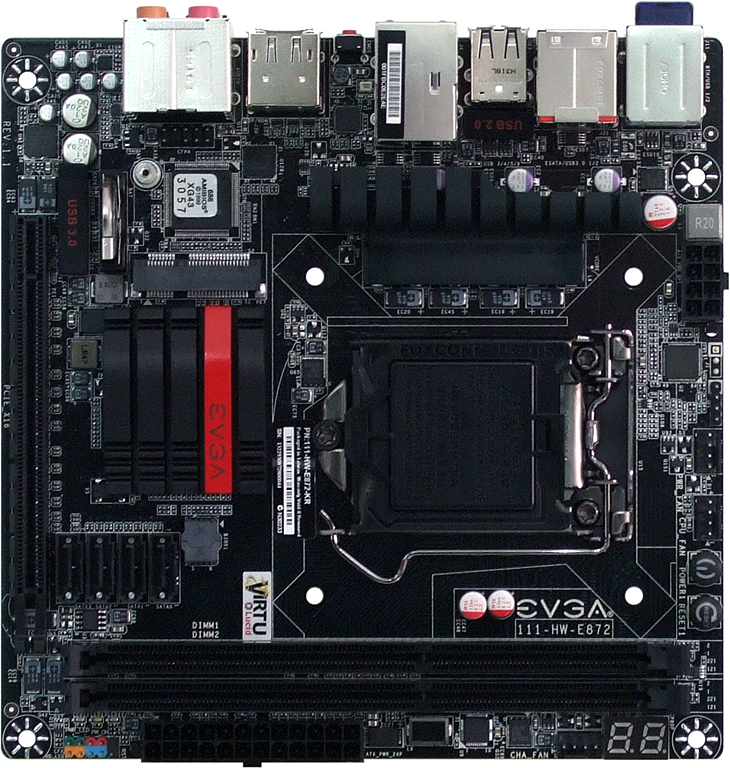Five Z87 Motherboards For Your Mini-ITX Build, Reviewed
Z87 rules the PC enthusiast market by exposing the Haswell architecture's full feature set. We're particularly interested in mini-ITX-based platforms able to integrate Z87 in a compact form factor. Five boards contend for supremacy of compact computing.
EVGA Z87 Stinger
While most of its competitors scrambled to find room to retain all of the Z87 Express PCH's natively-supported features using a mini-ITX form factor, EVGA made space for power and reset buttons, plus a dual-digit system status display. Dedicated to gamers, and by extension to overclockers, the company got there by focusing on the unique needs of the mini-ITX-based gaming system market.
The first thing we noticed was that the board has only four internal SATA 6Gb/s ports, which makes sense when most small cases have no more than four drive bays anyway. A tiny heat sink serves a similarly downsized four-phase voltage regulator, which also works for us since Haswell’s heat issues normally prevent it from capitalizing on the additional capacity of larger regulators. EVGA also gets rid of rarely-used connections like legacy communications ports and the TPM.
That’s not to say the board is stripped. We still find, for example, the full range of front-panel headers, including USB 3.0, USB 2.0, and analog audio I/O. In fact, front-panel audio is a significant addition to the Z87 Stinger, since EVGA neglected to include it on the company's Z77-based predecessor. Also, one of the missing SATA 6Gb/s ports gets re-routed to eSATA.
EVGA even includes a decorative cover so you don't have to look at parts of the board that don't add anything aesthetically. In fact, Wi-Fi is the only feature notably missing from the Z87 Stinger compared to competing products.
The Z87 Stinger has a mini-PCIe slot into which you can drop your choice of wireless networking controller or other compatible device. EVGA even includes a place on the board's I/O shield for mounting antenna leads. On the other hand, if the company wanted to provide its customers with added configuration flexibility, it should have bundled the break-out cables that aren’t included with most mini-PCIe-based wireless modules.
The Z87 Stinger's manual is universal, and based on EVGA's other products. You'll need to rely on its additional configuration sheet to determine the location and function of various connectors, and know to dismiss anything listed in the manual but not found on the board.
Get Tom's Hardware's best news and in-depth reviews, straight to your inbox.
-
PEJUman Why would one pay extra for ASUS's power delivery if it didn't yield any additional OC/DRAM stability? In the end, ASRock features & cheaper price should be a better option here.Reply -
Crashman Reply
Yes, they've sent one for another article. If the site did multiple items per manufacturer the article would take weeks to finish. That wouldn't be a problem if all Tom's Hardware did was motherboards :p12025866 said:Here is another MSI ITX board
ASRock's cheaper features also made it a competitor with the cheaper boards for the value award. Since it competed well for both awards, it had to get a different award.12025873 said:Why would one pay extra for ASUS's power delivery if it didn't yield any additional OC/DRAM stability? In the end, ASRock features & cheaper price should be a better option here.
-
nukemaster While some may not like the layout, the Gigabyte and MSI layout should work well in some cases like the SG05 from SilverStone. The top mounted power and sata ports help keep wires out of the air flow path.Reply
More room between the PCI-E and CPU LGA is nice on the Asus as are all the features.
I am still running an older H55n usb3 24/7 and it has been quite stable and cool and low on power consumption. Shame that this new gigabyte board has higher power and temperature levels. -
xkm1948 Since most of them has built in Wi-Fi. Will it be better to include a Wi-Fi test column?Reply -
Crashman Reply
We formerly had a controller reviewer, and I'd like to see someone take on this task again. A separate article on the controllers (with everything else identical) wouldn't tell you anything about the antennas included with different products, but antennas are cheaply replaceable.12025986 said:Since most of them has built in Wi-Fi. Will it be better to include a Wi-Fi test column?
-
KrazyKap Is the Asus Z87 Pro the same as the Deluxe? Seems to be region specific but I can't find the difference. Help? I've just bought the Pro for myself as it is only slightly more than the MSI or Gigabyte options.Reply -
vertexx Let's just roll some dice and toss out some awards, eh? Couldn't help but laugh through the conclusion.Reply
Overall it's good to see the roundup. Would have liked to see post times. With SSD storage, motherboard post times are now becoming the longer wait in a system boot up.
Also interested in thoughts on reasons for Z87 mobos for a standard non-overclocking build. For a non-overclocked gaming ITX PC, say with an I3 or low-end I5, are there any compelling reasons to pay the Z87 premium over, say an H81, which can run $100 cheaper? -
rolli59 Nice review and boards, conclusion is all good buy's depending on what features you want except the EVGA.Reply




